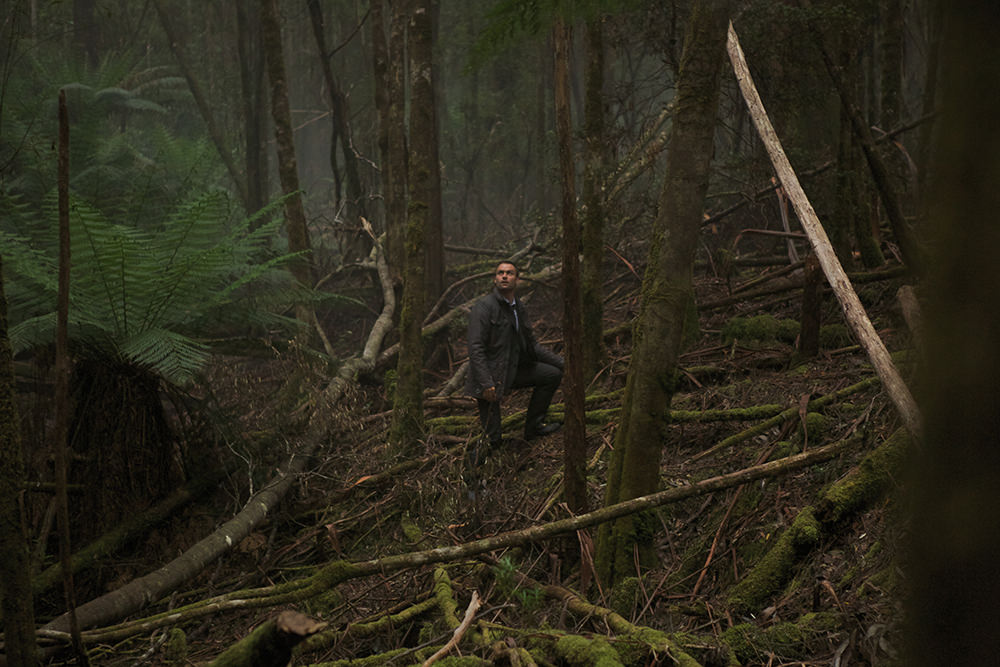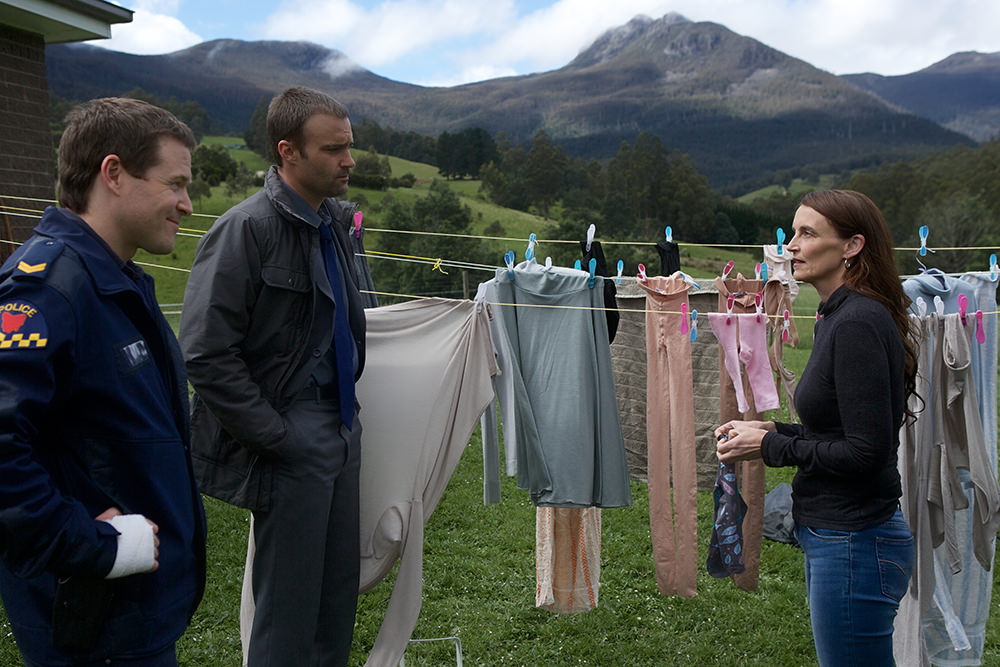Location, location, location
The landscape has a starring role in Foxtel’s new drama series The Kettering Incident. Shot entirely in southern Tasmania, the eight part series is described by producers as a mystery with otherworldly tones which fits right in with the Modern Gothic genre associated with the island’s haunting beauty. Early glimpses of the show suggest it has a look similar to the empty majestic landscapes that were such a strong element in Top of the Lake.
 Matt Le Nevez in The Kettering Incident/Giovanni Lovisetto
Matt Le Nevez in The Kettering Incident/Giovanni Lovisetto
Unlike urban location scouting where tools like GPS technology make the job easier, in Tasmania, Google Earth won’t find you the right kind of scenery. The remoteness of the terrain presents unique logistical challenges: where do you find virgin rainforest with good road access?
Fortunately Hobart is blessed with a diversity of dramatic landscapes within close proximity. You can be on one of the world’s most photogenic beaches in the morning and shooting snowcapped mountains in the afternoon. Some even have parking facilities…
Location scout & manager Brendan Shanley was responsible for finding the hidden places that give The Kettering Incident its visual identity. Experienced at working in the Tasmanian wilderness on films like The Hunter, The Last Confessions of Alexander Pearce and The Light Between Oceans, Shanley has an insider’s knowledge of the bush and an understanding of the delicate negotiations necessary when trying to shoot in fragile ecosystems.
“You have to have a good relationship with National Parks and Wildlife who are the custodians of many of the remote places we wanted to shoot. There are rules about not stepping off footpaths to protect that environment but there is often room for negotiation like asking permission to place a camera off the path with a minimal crew, so long as there is mutual respect for the environment and we’ve managed to keep that balance.”
Most of Kettering was shot in the Huon and Derwent Valleys which Shanley knows well from working on commercials shoots for Boag’s beer which is brewed in nearby Launceston. The brand features the islands pristine waters in its stills campaigns and TV ads.
The series was co-created and co-produced by Tasmanian filmmaker Vicki Madden along with Vincent Sheehan. Vincent was familiar with the island state’s atmospheric moodiness having worked on The Hunter. While others might find the weather’s unpredictability a concern, for Vincent it was a plus. “He wanted fog and snow and he got it” says Shanley. “We scored a fantastic snowstorm on Mount Wellington on day one and had some sleet at Mountain River. Ironically when we headed north we had to create a snow storm and because we were in a sensitive wilderness area, the snow we made had to be biodegradable.”
 Henry Nixon, Matt Le Nevez and Suzi Dougherty in The Kettering Incident/Giovanni Lovisetto
Henry Nixon, Matt Le Nevez and Suzi Dougherty in The Kettering Incident/Giovanni Lovisetto
“Most productions come in the winter because of the stunning low light which looks so fantastic on film, but the temperatures can take people out of their comfort zone. Kettering was an eighteen-week shoot and we did not lose a single day to weather, we just adapted to the changing conditions. Another aspect of remote locations is that accommodation is not to the usual standard. The cast and crew on The Last Confessions of Alexander Pearce ended up staying in old mining town industrial huts with communal showers. But that became kind of fun and a good bonding exercise.”
Turning adversity to advantage, Shanley sourced a burned out landscape at Westaway past New Norfolk for The Outlaw Michael Howe following the tragic sweeping bushfires of 2013. “What’s great is when a production leaves something positive behind. On The Light Between Oceans, some of the shoot was at Stanley because they wanted to use a rock formation called the Nut. They rebuilt one of the derelict jetties which has been a great benefit to the community.”
But not all of Tasmania’s most photogenic destinations are as amenable. The convict site at Port Arthur is “hard to access unless the production is educational and historically significant. A Chinese reality TV show with a cast and crew of 80 approached me about using it as a location for a sort of treasure hunt sequence. They had an estimated audience of three hundred and fifty million. Port Arthur declined but I found alternatives: the Gordon Dam for an abseiling sequence and a working sheep station at Hamilton, which also laid on a barbecue’”
Shanley’s wife and partner at Latitude Films, producer Fiona McConaghy, says one of the advantage of filming in Tasmania is that the population is not cynical or film-jaded, which makes them keen to help if you ask to borrow their property.
“One challenge is that we have limited crew based here, but the industry is developing and up-skilling all the time which means productions don’t have to bring everyone over from the mainland. On Kettering we had thirteen attachments through a partnership with Screen Tasmania; three or four of them ended up staying on the production in paid employment which was a very encouraging outcome. There is a wealth of talent here in Tasmania, both crew and cast.”
“Crew that come over from the mainland are not always used to driving with abundant wildlife on the road at dawn and dusk, no street lights and ice as a driving hazard. But it is worth it for the unique qualities of the place – you can’t cheat those. If you want your story to be set in Tasmania, it has to be shot in Tasmania.”
The Kettering Incident screens on Foxtel on 4 July.

What to read next
Rosehaven’s Luke McGregor on his increased admiration for Rob Sitch and why Tasmania is the next Hollywood.
05 Oct 2016
Caris Bizzaca